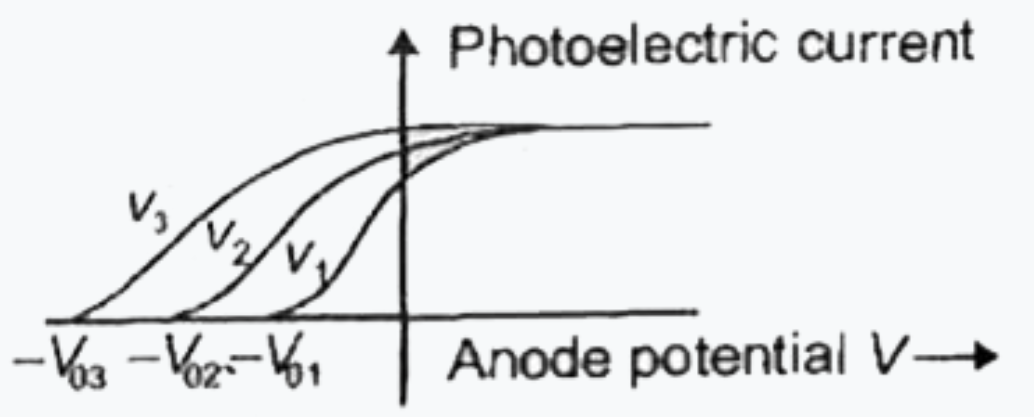In photoelectric effect, the photoelectric current is independent of
intensity of incident light
potential difference applied between the two electrodes
the nature of emitter material
frequency of incident light
The correct Answer is:D
To solve the question regarding the independence of photoelectric current in the photoelectric effect, we can follow these steps:
1. Understand the Photoelectric Effect: The photoelectric effect refers to the phenomenon where electrons are emitted from a material (usually a metal) when it is exposed to light (or electromagnetic radiation) above a certain threshold frequency.
2. Identify Key Factors: The photoelectric current is influenced by several factors, including:
- Intensity of Incident Light: This affects the number of photons hitting the surface and thus the number of emitted electrons.
- Frequency of Incident Light: This affects the energy of the emitted electrons but not the number of electrons emitted if the frequency is above the threshold.
- Material Properties: The work function of the material determines the threshold frequency.
- Voltage Applied: The applied voltage can affect the collection of emitted electrons, thus affecting the current.
3. Determine Independence: The question asks for the factor that the photoelectric current is independent of.
- The photoelectric current is directly proportional to the intensity of the incident radiation (more photons lead to more emitted electrons).
- The photoelectric current is also affected by the applied voltage.
- The frequency of the incident light, however, only affects the kinetic energy of the emitted electrons and does not affect the number of electrons emitted (as long as the frequency is above the threshold). Therefore, the photoelectric current does not depend on the frequency of the incident light.
4. Conclusion: Based on the analysis, we can conclude that the photoelectric current is independent of the frequency of the incident light.
Final Answer:
The photoelectric current is independent of the frequency of the incident light.
---
- Intensity of Incident Light: This affects the number of photons hitting the surface and thus the number of emitted electrons.
- Frequency of Incident Light: This affects the energy of the emitted electrons but not the number of electrons emitted if the frequency is above the threshold.
- Material Properties: The work function of the material determines the threshold frequency.
- Voltage Applied: The applied voltage can affect the collection of emitted electrons, thus affecting the current.
- The photoelectric current is directly proportional to the intensity of the incident radiation (more photons lead to more emitted electrons).
- The photoelectric current is also affected by the applied voltage.
- The frequency of the incident light, however, only affects the kinetic energy of the emitted electrons and does not affect the number of electrons emitted (as long as the frequency is above the threshold). Therefore, the photoelectric current does not depend on the frequency of the incident light.
The photoelectric current is independent of the frequency of the incident light.
Topper's Solved these Questions
- DUAL NATURE OF RADIATION AND MATTER BOOK - NCERT FINGERTPS ENGLISHCHAPTER - DUAL NATURE OF RADIATION AND MATTER EXERCISE - EINSTEIN S PHOTOELECTRIC EQUATION : ENERGY QUANTUM OF RADIATION
23 Videos
- DUAL NATURE OF RADIATION AND MATTER BOOK - NCERT FINGERTPS ENGLISHCHAPTER - DUAL NATURE OF RADIATION AND MATTER EXERCISE - PARTICLE NATURE OF LIGHT : THE PHOTON
19 Videos
- DUAL NATURE OF RADIATION AND MATTER BOOK - NCERT FINGERTPS ENGLISHCHAPTER - DUAL NATURE OF RADIATION AND MATTER EXERCISE - PHOTOELECTRIC EFFECT
2 Videos
- CURRENT ELECTRICITYBOOK - NCERT FINGERTPS ENGLISHCHAPTER - CURRENT ELECTRICITYEXERCISE - Assertion And Reason
15 Videos
- ELECTRIC CHARGES AND FIELDSBOOK - NCERT FINGERTPS ENGLISHCHAPTER - ELECTRIC CHARGES AND FIELDSEXERCISE - Assertion And Reason
15 Videos
Similar Questions
Knowledge Check
In photoelectric effect, stopping potential depends on
Afrequency of incident lightBnature of the emitter materialCintensity of incident lightDboth (a) and (b)
In a photoelectric effect, electrons are emitted
View SolutionWave nature of light cannot explain photoelectric effect because in photoelectric effect , it is seen that
View SolutionA : On increasing the intensity of light , the number of photoelectrons emitted is more . Also the kinetic energy of each photo increases but the photoelectric current is constant
R : Photoelectric current is independent of intensity but increases with increasing frequency incident radiation
View SolutionIn photoelectric effect, the number of photoelectrons emitted is proportional to :
View SolutionIn photoelectric effect, the number of photoelectrons emitted is proportional to :
View SolutionThe photoelectric work function
View SolutionWhen stopping potential is applied in an experiment on photoelectric effect, no photo current is observed. This means that
View Solution

